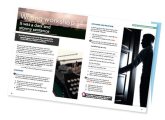Controlled writing assessments are soon to be a thing of the past; is this cause for a sigh of relief or a reason to rethink your career choice? Whatever your reaction, the reality is that no longer will there have to be the long hours of preparation, checking and re-checking, and chasing work the week before the assessment. Gone will be the sinking feeling that despite the aforementioned time spent on said preparation, there will always be at least one pupil who will have to look up the word ‘Hello’ within the first minute because their “mind has gone blank” – not to mention pieces of work that, despite the recommended 200 word minimum, consist of three stark sentences.
Now there’s a different concern: no ‘official’ preparation, no 40 words, no dictionary, no idea what the writing topic is going to be! The reality is that students are going to need to know how to write in the target language, creatively, and by themselves. A good way to build up their confidence is to start to create longer pieces of written work as a group. This can be done at a very basic level with KS3 and developed and extended into KS4. Here are a few ideas, which will hopefully give pupils the skills to be able to tackle the writing component of the exam, make them more confident writers, and prevent language teachers everywhere from contemplating retirement…
Why teach this?
In this lesson, students start to use topic specific vocabulary to practise and improve their skills, which will help them to write more creatively. The ultimate goal is to be able to produce an extended piece of writing.
Starter activity
As students enter the room each is given a slip of paper which contains a different word in the target language. They then have to write a brief sentence that includes the word. This activity can be done individually or in pairs, and you can give additional differentiated guidelines, e.g. they need to write in a particular tense, or they can only use a certain amount of words. The words they are given can be completely random if you are doing this for fun or from a certain topic area (holidays, environment, etc.) This activity is desiged to encourage pupils to write more spontaneously on any subject they are given.
Main activity
1. Checks and balances
It is very rare that every student in the class will write a completely correct sentence, so the first task could be checking each other’s work and correcting it accordingly. I have found that this works better if the work of the less able students is swapped with that of the MAGT learners, as the latter are more likely to spot any errors, and their work can be useful for others to view and learn from their peers. As students become more accustomed to this activity and more confident in their writing skills, an additional task could be to have individuals, pairs or groups extend someone else’s sentence. This encourages pupils to incorporate connectives, adjectives, etc.
2. Get connected
Now that a selection of sentences has been completed it is time to try to place them together to form one larger piece of work. Split the topic into three or four categories (for example, ‘holidays’ could be divided into: ‘the journey’, ‘food and drink’, ‘sport and leisure’and ‘tourist activities’). Allocate each category to a corner of the room and ask students to take their sentence to the area where it best fits. When all the students have decided and moved, get them to read their sentences aloud to each other and, as a group, organise all the sentences into one or two paragraphs. This gives them the opportunity to learn about how to structure a paragraph and make sure that their sentences follow a logical order. As their confidence increases, they can start to use a range of connectives to merge the sentences together; they can also edit them to make them fit better into the paragraph.
Finally, all the paragraphs can be placed together to form one extended piece of writing.
Home learning
When setting writing homework, rather than make it open ended, it may help to give pupils specific guidelines.
For example:
• They must use a specific collection of nouns.
• They must use two feminine adjectives.
• They must use one plural adjective.
• They must use four connectives.
• They must use only the preterite and the present tense.
This will make pupils think about what they are writing and will improve their accuracy as they will begin to recognise when they should be using masculine, feminine and plural.
You could also use these sentences as the basis for the main paragraph building activity in the next lesson.
Take it further
Have a word of the week competition in your classroom, for which pupils have to come up with an original sentence featuring a word that’s prominently on display. Reward sentences that are especially creative and include, for example, a different tense, a selection of adjectives, connectives etc. with a small prize. Silly words work particularly well for this, and encourage students to write freely, without any constraints. The sentences could be distributed to the whole class for them to correct and translate as a home learning task.
Play ‘word snake’ – pass a piece of paper to a student and ask them to write a word on it and pass it on. The next person must add a word, building a sentence, and pass it on again. This is a fun activity which gets students to think carefully about sentence formation and helps them develop their own writing skills. They should also be encouraged to correct any mistakes as the paper travels around the class.
+Key resources
ALL Connect provides CPD for teachers in mainstream education to support the new languages programmes of study at Key Stages 2 and 3. The project has produced training materials on major curriculum themes, which are freely available to download from the ALL Connect Blog: allconnectblog.wordpress.com.
KS3 materials produced by the project include resources on Extended Writing, Grammar, Literature, Spontaneous Speaking and Translation. New for 2016: the KS2-3 Transition Toolkit is a practical, useful guide containing a set of ‘tools’ (ideas, strategies and resources), designed to inform the process of transition in language teaching and learning between KS2 and KS3.
Summary
A great activity to help pupils understand paragraph structure is sentence ordering. Create or find a text and cut it into strips. Pair students up, and give a strip to each pair. They then have to work as a class to recreate the original text (which could even be a recycled piece of the class’ own work). Alternatively, using mini whiteboards, have pupils ‘finish the sentence’. You place the first part of a sentence on the IWB, for example, Normalmente mis amigos… and pupils have to come up with the second half and write it on their whiteboard.
About our expert
Anthony Cahill is the head of modern foreign languages at Hazelwick School in Crawley, West Sussex.








